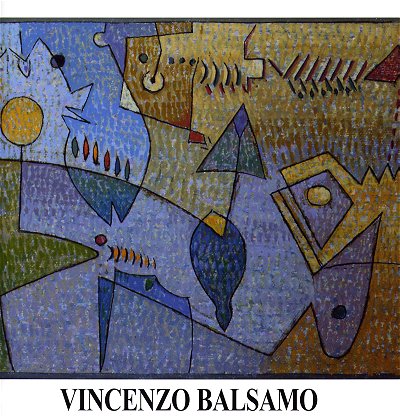|
Artfully dislocated across the canvas in Vincenzo Balsamo’s works, the structural
elements in his compositions slowly invade and fill up the whole pictorial space. Actually, they somehow give shape to a text, a visual text complete in itself.
The viewer’s eye travels along the network of lines flowing throughout the whole composition. As if moved by an array of rebellious forces, these add vitality
to the pictorial surface and, at the same time, almost seem to dematerialize it. This series including fifty-eight small format paintings does not suggest a distanced look
aimed at securing a more favourable vantage point, but rather a closer one, inviting the observer to bend and lean over it, eager to penetrate a secret world conjured
by this analitical form of writing. The code one is offered by the artist brings to mind the masters of XX century abstraction, revered as fathers and yet reinterpreted
at the light of his individual conception.
One immediately senses the artist’s invitation to enter his own creative dimension and decipher his language-world, provided one has
definetively abdicated his own ordinary point of view. The observer is utterly stricken by the graphic quality of his work. Here, breaking lines suddenly interrupt
their quiet flow; there, one can spot floating shapes striving to preserve a balance. The line, crossing unhindered the canvas’ entire extension, frequently deviates
in multiple directions suggesting its potential desire of infinity. Yet, in these works line punctually explores new spaces, encloses unknown islands, or reveals
unexpected geometrical patterns. At their outmost thinness, they overlap, proceed side by side, outrun one another, though never disavowing their unrestrained
existence. Line is modulated to evoke alternatively graphic, formal and rythmic labirinths. Top and bottom are clearly defined by the artist’s intention to convey
his own emotional experiences to the viewer always allowing him a personal interpretation.
Balsamo designs the chromatic permutations of his works as a miniaturist. A precious succession of distinct short brushstrokes unfolds,
exempt from purely naturalistic reproduction or even explicitly recalling it as in the landscape in Composition n.4, which sets itself as an exception within the series.
The chromatic quality is thus mantained vibrant by means of the vast range of shades shifting through the colour chart. The blues and reds, more than any others,
add to the impression of this endless motion. It is a symbolic contrast hinting at the primordial opposition existing between blue, a masculine, uranic colour, and a
feminine, otherwordly one such as red. Often enhanced against red ochres and golden earthen hues, the intrinsic vitality of red, described by Kandinsky as being
so "typically warm, vivid and restless", finds its ideal fulfilment in the dynamic strength of blue bleeding into sky tones. We are told by the same source to what
extent dark colours are strengthened by round shapes. Some inner motion recalls the stream of consciousness, never loosing its unity within the flow of that
all-devouring and yet preserving entity called time. It is in the corners of memory that one discovers unexpected treasures: the suggestive breaking of waves,
the ever-changing colour of primordial seas.... the reminiscence of their living creatures.
Across the canvas’ surface an ambiguous, eternal thrust, connecting the unsteady nature of all-corrupting motion and the durability
of that which is timeless, still and perennial, is achieved. Suspended, light-ridden shapes lay still and yet move throughout the composition. One could presume
the artist arranged them or, rather, had found them "arranged" during his search. This static displacement of shapes proves itself to be a statement of awareness
of their own purpose, at the same time. Compelled by the vivid hues and exceedingly thin brushstrokes, enclosed within continuous outlines, vibrations become
prominent, relentless. A present and potential condition, at the same time. Each painting relies upon a calculated network of rhythmic outlines, which nonetheless
it tends to defy in a conscious attempt at fragmentation, thereby generating new patterns. Balsamo, though, is not pursuing a way to straighten out all
dichotomies - which he feels to lay at the core of any artistic search. Instead, he seems to opt for an inexhaustible existential flux, sought after just because
of its undefined balance and, by no means, because of the comfortable certainties provided by a reassuring theory.
His paintings cannot be conceived as private diaries or mere expressions related to some urgent personal tensions. They rather provide
evidence of the absolute, empathic osmosis between the artist and the painted each time judgement and creativity inspire countless different modulations. Never
identical and apparently triggered by never-ending metamorphoses, these assert as the main elements that still inform his poetics and justify his search. By giving
new shape to its various solutions, Balsamo’s creative activity unlashes form from the ties of appearance and releases it into that circular, infinite dimension where
dichotomies with their myriad combinations (warm-cold, affirmation-negation, male-female) are effective. After all, these are the meaningful impulses that
characterize our lives. This is, namely, the very living force that sustains or humiliates us. There lies what perhaps the artist ackowledges as our common path.
Thus, the art of Vincenzo Balsamo asserts itself as a quiet, though no less profound, meditation upon the world and man’s fate.
Gianni Cerioli |

